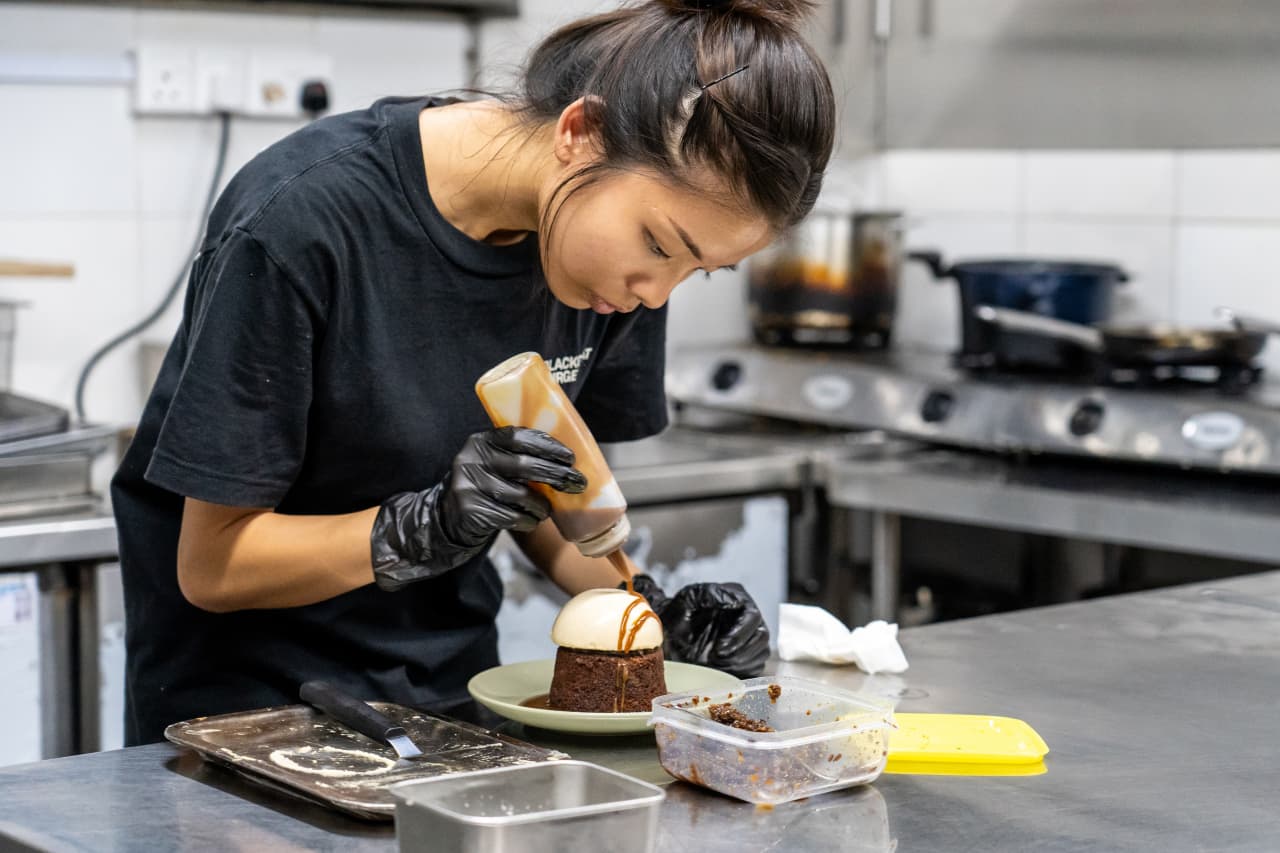New Grads Have No Idea How to Behave in the Office. Help Is on the Way.
As the Class of 2023 enters the workforce, employers are seeing a lack of the skills necessary to navigate the office. The solution: instruction on how to send an email, the right way to buttonhole the boss and what not to wear.
Recent graduates might be great at accounting or coding, but they need a little help when it comes to dinner parties and dress codes.
Many members of the class of 2023 were freshmen in college in the spring of 2020, when campuses shuttered due to the Covid-19 pandemic. They spent the rest of their college years partially in virtual mode with hybrid internships and virtual classes. Students didn’t learn some of the so-called soft skills they might have in the past by osmosis on the job, from mentors and by practicing on campus.
To address deficiencies in everything from elevator chitchat to presentation skills, companies, universities and recruiters are coming up with ways to train new hires and give them clear advice. They are eating it up.
Recent graduate Joslynn Odom had her first hybrid internship after her junior year and found working in person to be draining thanks to wearing professional attire and staying energetic consistently. It made her realise that she needed to sharpen her communication and networking skills.
Programming arranged by her college, Miami University in Ohio, has since helped. Just before graduation she attended an etiquette dinner where she learned to follow the lead of more senior leaders over dinner: Eat at their pace, discuss neutral topics and avoid personal questions. When buttering bread, it is best to put a slab on one’s own bread plate before applying it to a roll, and when cutting food, holding the fork hump-side up is best, she said.
“Knowing that, I feel more confident,” she said.
William Lopez-Gudiel, 23 years old, interned last year for Warner Bros. Discovery and found a presentation on office dynamics especially helpful. It covered dress codes, navigating interpersonal relationships and what working in person is like, he said.
The company said it has offered similar guidance in the past. Some of it felt like common sense to Lopez-Gudiel, who graduated in December from George Mason University and is a self-described extrovert.
But Lopez-Gudiel ultimately appreciated the information, realising that the pandemic may have limited what soft skills he might have learned at past work experiences. He will be working at the company full time as a software developer.
Many soon-to-be graduates are itching to get rid of Zoom and work face-to-face with co-workers where their interpersonal skills will be quickly tested. In an April survey of about 700 Class of 2023 graduates from the virtual student-health company TimelyCare, 53% said they wanted a fully in-person work environment, while 21% said they wanted to be fully remote.
Graduates’ disrupted college experience might mean they struggle with the basics reading colleagues’ cues or navigating a meeting, said Heidi Brooks, a senior lecturer in organizational behavior at Yale University’s School of Management. In class, when students didn’t have cameras on, that was harder to determine.
New hires will need to learn “those nuances of, how do you actually create enough connection, visibility, ability to manoeuvre,” she said.
The missing piece for young professionals who have graduated since 2020, in fact, has been no real proximity to mentorship and leadership, recruiters say.
“This is so much more important today,” said Sandy Torchia, vice chair of talent and culture at KPMG, whose full-time hires this summer and fall will go to the firm’s training facility in Florida where they’ll get new presentation training.
They’ll practice scenarios involving conflict within teams, plus the basics of talking in person—as simple as how to introduce yourself to a client or colleague. Key tips include maintaining eye contact, taking pauses and avoiding jargon. It is also best to listen carefully to others, and to adjust your introduction to highlight pieces of your background that will be most interesting to them.
The company has found that some young professionals are stiff, talk too fast, or rely too much on filler words like “um,” as they presented. Some of the employees said they wanted to feel more comfortable, too.
Allan Rubio, 21 years old was a freshman at Dartmouth College in the spring of 2020. Online classes continued all through his sophomore year, which Rubio completed from his family’s home in Bangkok. Course sessions stretched to 11 p.m. or sometimes 2 a.m. local time, he said.
Professors were far more flexible on deadlines during the pandemic, amenable to extensions if students asked, he said. When Rubio had an in-person internship last summer, he realised his manager, team or client depended on him meeting deadlines.
Presentation skills are also something Rubio needs to learn better, he said. He had presented virtually in academic classes, and often kept a few thoughts and scripted language in a Notes file on screen—or on a separate device nearby. Once on a video call, he said, he blamed an internet delay while he stopped talking mid sentence and collected his thoughts.
None of those aids could help him through presenting in-person on stage at a hackathon on campus. It was more difficult than he expected, he said.
Since then Rubio, who graduated this month, has rehearsed extensively before live presentations. He lays out key points and slims a longer script into bullet points before memorising key areas.
Though new hires are digital natives, today’s graduates’ professional email skills need improvement, said Jialan Wang, an assistant professor of finance at the University of Illinois at Urbana-Champaign.
Many won’t acknowledge important messages but will expect a response from professors immediately, even over holidays, she said.
Michigan State University’s business-school career centre has urged companies to be explicit about what students should expect at work, to over-communicate details about how a first day will play out, what to wear and what people typically do for lunch.
The school last year began requiring many business students to take classes on soft skills in the workplace, after observing that students are more awkward and unsure when they network than they used to be, said Marla McGraw, director of career management.
The program goes step by step through an in-person networking conversation. In one handout, the centre instructs students to introduce themselves by their first and last name. “STOP! Let them tell you their name,” it reads.
Later it urges the students to share that they are interested in hearing about opportunities at the company and share that they follow the company closely, are familiar with its products or services or know someone who interned there, among other options.
“STOP! Pause for only a few seconds to see if they offer any questions or input on your above comments. They may ask you for your resume.”
Students should keep an eye out for signs that a person is trying to end a conversation, McGraw added. Someone might begin to gather their things, or look around the room, signalling they need to talk to another person. Often, one can facilitate a smooth exit by saying, “Well, thanks so much. It’s been a pleasure.”
Professional-services firms PricewaterhouseCoopers and Protiviti have had to tell some young workers what types of clothes are appropriate, including for client-site visits.
Many people are dressing less formally, said Scott Redfearn, Protiviti’s executive vice president of global human resources.
Now the company defines what it means by business casual—including slacks, tailored denim, sport jackets, dresses, skirts, collared shirts, blouses, sweaters and professional footwear—and explains why it’s important to maintain a serious professional image. The company also relays that when it is appropriate to wear bluejeans, darker hues without rips are best, he said.
The company has tried to be proactive when it shares broad guidance about attire, but when a worker shows up in athleisure or flip-flops, that is best handled with a one-on-one conversation.
“Working hybrid brings a lot more decisions to the individual employee,” Redfearn said.
During the pandemic, the firm extended its onboarding process to a series of small-group virtual meetings that took place over a full year. One topic includes making conversation as a social skill, he said. It includes an improv-based public-speaking workshop, where in one prompt, participants need to describe themselves in three words quickly, going with their first impulse. The company said the sessions help workers to find their authentic communication styles.
Protiviti hosts social gatherings around in-person meetings so that workers can practice.
Redfearn said he gives a pep talk to new graduates, urging them to introduce themselves around the office, stick their hand out and smile. Another tip: Have a prepared question ready to ask if needed.
—Ray A. Smith contributed to this article.
 Copyright 2020, Dow Jones & Company, Inc. All Rights Reserved Worldwide. LEARN MORE
Copyright 2020, Dow Jones & Company, Inc. All Rights Reserved Worldwide. LEARN MORE
This stylish family home combines a classic palette and finishes with a flexible floorplan
Just 55 minutes from Sydney, make this your creative getaway located in the majestic Hawkesbury region.
No trip to Singapore is complete without a meal (or 12) at its hawker centres, where stalls sell multicultural dishes from generations-old recipes. But rising costs and demographic change are threatening the beloved tradition.
In Singapore, it’s not unusual for total strangers to ask, “Have you eaten yet?” A greeting akin to “Good morning,” it invariably leads to follow-up questions. What did you eat? Where did you eat it? Was it good? Greeters reserve the right to judge your responses and offer advice, solicited or otherwise, on where you should eat next.
Locals will often joke that gastronomic opinions can make (and break) relationships and that eating is a national pastime. And why wouldn’t it be? In a nexus of colliding cultures—a place where Malays, Indians, Chinese and Europeans have brushed shoulders and shared meals for centuries—the mix of flavours coming out of kitchens in this country is enough to make you believe in world peace.
While Michelin stars spangle Singapore’s restaurant scene , to truly understand the city’s relationship with food, you have to venture to the hawker centres. A core aspect of daily life, hawker centres sprang up in numbers during the 1970s, built by authorities looking to sanitise and formalise the city’s street-food scene. Today, 121 government-run hawker centres feature food stalls that specialise in dishes from the country’s various ethnic groups. In one of the world’s most expensive cities, hawker dishes are shockingly cheap: A full meal can cost as little as $3.
Over the course of many visits to Singapore, I’ve fallen in love with these places—and with the scavenger hunts to find meals I’ll never forget: delicate bowls of laksa noodle soup, where brisk lashes of heat interrupt addictive swirls of umami; impossibly flaky roti prata dipped in curry; the beautiful simplicity of an immaculately roasted duck leg. In a futuristic and at times sterile city, hawker centres throw back to the past and offer a rare glimpse of something human in scale. To an outsider like me, sitting at a table amid the din of the lunch-hour rush can feel like glimpsing the city’s soul through all the concrete and glitz.
So I’ve been alarmed in recent years to hear about the supposed demise of hawker centres. Would-be hawkers have to bid for stalls from the government, and rents are climbing . An upwardly mobile generation doesn’t want to take over from their parents. On a recent trip to Singapore, I enlisted my brother, who lives there, and as we ate our way across the city, we searched for signs of life—and hopefully a peek into what the future holds.
At Amoy Street Food Centre, near the central business district, 32-year-old Kai Jin Thng has done the math. To turn a profit at his stall, Jin’s Noodle , he says, he has to churn out at least 150 $4 bowls of kolo mee , a Malaysian dish featuring savoury pork over a bed of springy noodles, in 120 minutes of lunch service. With his sister as sous-chef, he slings the bowls with frenetic focus.
Thng dropped out of school as a teenager to work in his father’s stall selling wonton mee , a staple noodle dish, and is quick to say no when I ask if he wants his daughter to take over the stall one day.
“The tradition is fading and I believe that in the next 10 or 15 years, it’s only going to get worse,” Thng said. “The new generation prefers to put on their tie and their white collar—nobody really wants to get their hands dirty.”
In 2020, the National Environment Agency , which oversees hawker centres, put the median age of hawkers at 60. When I did encounter younger people like Thng in the trade, I found they persevered out of stubbornness, a desire to innovate on a deep-seated tradition—or some combination of both.
Later that afternoon, looking for a momentary reprieve from Singapore’s crushing humidity, we ducked into Market Street Hawker Centre and bought juice made from fresh calamansi, a small citrus fruit.
Jamilah Beevi, 29, was working the shop with her father, who, at 64, has been a hawker since he was 12. “I originally stepped in out of filial duty,” she said. “But I find it to be really fulfilling work…I see it as a generational shop, so I don’t want to let that die.” When I asked her father when he’d retire, he confidently said he’d hang up his apron next year. “He’s been saying that for many years,” Beevi said, laughing.
More than one Singaporean told me that to truly appreciate what’s at stake in the hawker tradition’s threatened collapse, I’d need to leave the neighbourhoods where most tourists spend their time, and venture to the Heartland, the residential communities outside the central business district. There, hawker centres, often combined with markets, are strategically located near dense housing developments, where they cater to the 77% of Singaporeans who live in government-subsidised apartments.
We ate laksa from a stall at Ghim Moh Market and Food Centre, where families enjoyed their Sunday. At Redhill Food Centre, a similar chorus of chattering voices and clattering cutlery filled the space, as diners lined up for prawn noodles and chicken rice. Near our table, a couple hungrily unwrapped a package of durian, a coveted fruit banned from public transportation and some hotels for its strong aroma. It all seemed like business as usual.
Then we went to Blackgoat . Tucked in a corner of the Jalan Batu housing development, Blackgoat doesn’t look like an average hawker operation. An unusually large staff of six swirled around a stall where Fikri Amin Bin Rohaimi, 24, presided over a fiery grill and a seriously ambitious menu. A veteran of the three-Michelin-star Zén , Rohaimi started selling burgers from his apartment kitchen in 2019, before opening a hawker stall last year. We ordered everything on the menu and enjoyed a feast that would astound had it come out of a fully equipped restaurant kitchen; that it was all made in a 130-square-foot space seemed miraculous.
Mussels swam in a mushroom broth, spiked with Thai basil and chives. Huge, tender tiger prawns were grilled to perfection and smothered in toasted garlic and olive oil. Lamb was coated in a whisper of Sichuan peppercorns; Wagyu beef, in a homemade makrut-lime sauce. Then Ethel Yam, Blackgoat’s pastry chef prepared a date pudding with a mushroom semifreddo and a panna cotta drizzled in chamomile syrup. A group of elderly residents from the nearby towers watched, while sipping tiny glasses of Tiger beer.
Since opening his stall, Rohaimi told me, he’s seen his food referred to as “restaurant-level hawker food,” a categorisation he rejects, feeling it discounts what’s possible at a hawker centre. “If you eat hawker food, you know that it can often be much better than anything at a restaurant.”
He wants to open a restaurant eventually—or, leveraging his in-progress biomedical engineering degree, a food lab. But he sees the modern hawker centre not just as a steppingstone, but a place to experiment. “Because you only have to manage so many things, unlike at a restaurant, a hawker stall right now gives us a kind of limitlessness to try new things,” he said.
Using high-grade Australian beef and employing a whole staff, Rohaimi must charge more than typical hawker stalls, though his food, around $12 per 100 grams of steak, still costs far less than high-end restaurant fare. He’s found that people will pay for quality, he says, even if he first has to convince them to try the food.
At Yishun Park Hawker Centre (now temporarily closed for renovations), Nurl Asyraffie, 33, has encountered a similar dynamic since he started Kerabu by Arang , a stall specialising in “modern Malay food.” The day we came, he was selling ayam percik , a grilled chicken leg smothered in a bewitching turmeric-based marinade. As we ate, a hawker from another stall came over to inquire how much we’d paid. When we said around $10 a plate, she looked skeptical: “At least it’s a lot of food.”
Asyraffie, who opened the stall after a spell in private dining and at big-name restaurants in the region, says he’s used to dubious reactions. “I think the way you get people’s trust is you need to deliver,” he said. “Singapore is a melting pot; we’re used to trying new things, and we will pay for food we think is worth it.” He says a lot of the same older “uncles” who gawked at his prices, are now regulars. “New hawkers like me can fill a gap in the market, slightly higher than your chicken rice, but lower than a restaurant.”
But economics is only half the battle for a new generation of hawkers, says Seng Wun Song, a 64-year-old, semiretired economist who delves into the inner workings of Singapore’s food-and-beverage industry as a hobby. He thinks locals and tourists who come to hawker centers to look for “authentic” Singaporean food need to rethink what that amorphous catchall word really means. What people consider “heritage food,” he explains, is a mix of Malay, Chinese, Indian and European dishes that emerged from the country’s founding. “But Singapore is a trading hub where people come and go, and heritage moves and changes. Hawker food isn’t dying; it’s evolving so that it doesn’t die.”
This stylish family home combines a classic palette and finishes with a flexible floorplan
Just 55 minutes from Sydney, make this your creative getaway located in the majestic Hawkesbury region.






















